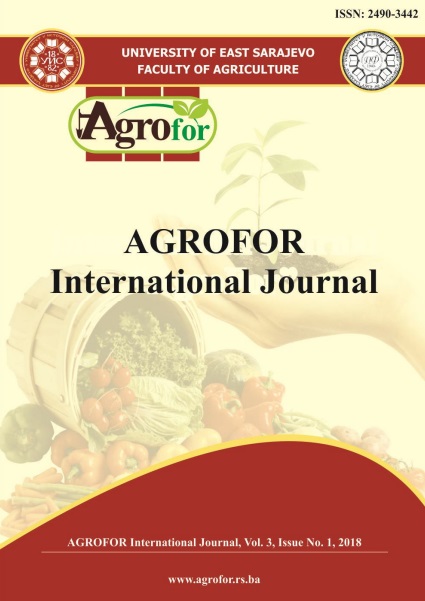THE EFFECT OF FOLIAR FERTILIZING ON THE CHEMICAL COMPOSITION OF PEPPERS GROWN IN PROTECTED SPACES IN THE STRUMICA AREA IN THE REPUBLIC OF MACEDONIA
DOI:
https://doi.org/10.7251/AGRENG1801106SAbstract
The influence of foliar fertilizing on the chemical composition of peppers grown in
protected spaces in the Strumica area was examined. The experiment was set in
four variants and three repetitions. The variants used in the experiment were, as
follows: Control (untreated variant); NPK+Ever green (55% organic matter,
2%w/w Mg, 2%w/w Fe, 2%w/w Zn, 2% w/w Mn, 0.5 %w/w Cu, 0.5 %w/w B);
NPK+Biolinfa (34% organic matter, 3% N, 5.80 % K2O); NPK+Oligomix (1.20 %
B, 0.10 % Cu, 4 % Fe, 1.50 % Mn, 0.10 % Mo, 2 % Zn). The experiment was set in
18 rows, and each variant and repetition comprised 62 plants. During the
vegetation period, 7 foliar treatments were made with listed fertilizers at a
concentration of 0.4%. Before setting up the experiment, an agrochemical analysis
of the soil was performed enabling the researchers to determine good soil fertility
with available nitrogen and potassium, and average fertility with available
phosphorus. Foliar fertilizing had a positive influence on the chemical composition
of the peppers. In the variants treated with different organic fertilizers the
researchers recorded a higher content of the analyzed parameters than in the
control, untreated variant. The highest average content of dry matter (14.80%), the
highest average content of ash (0.90%) and the highest average vitamin C content
(120 mg/100g) were determined in the pepper in Variant 2. The highest average
content of nitrogen (1.37%), phosphorus (0.53%), potassium (2.25%) and calcium
(1.42%) was also determined in the pepper in Variant 2. The highest average
magnesium (0.38%), iron (0.0067%) and manganese (0.0017 %) content was
determined in the pepper in Variant 3.

